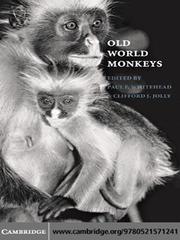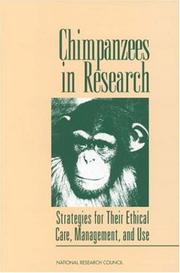| Listing 1 - 10 of 28 | << page >> |
Sort by
|
Book
ISBN: 9781631178528 1631178520 1631178512 9781631178511 Year: 2014 Publisher: New York : Nova Publishers,
Abstract | Keywords | Export | Availability | Bookmark
 Loading...
Loading...Choose an application
- Reference Manager
- EndNote
- RefWorks (Direct export to RefWorks)
This book is a collection of fascinating contributions from research experts around the world and their studies on monkeys, their brains, behaviors, endocrinology, diseases that pose potential threats to our species and the evolution of hormonal genes. If ""humans are like onions-made of layers"", as said by the character in the movie Shrek, monkeys are perhaps made of the same layers, except for the outermost. Thus, we share most of our genetics, physiology and pathology with them, in addition to our behavior and social conduct. These great similarities, particularly in metabolic aspects, are
Monkeys --- Haplorhini --- Primates --- Nervous system. --- Psychology. --- Diseases.
Book
ISBN: 9781620819364 1620819368 9781612099118 1612099114 Year: 2011 Publisher: New York.
Abstract | Keywords | Export | Availability | Bookmark
 Loading...
Loading...Choose an application
- Reference Manager
- EndNote
- RefWorks (Direct export to RefWorks)

ISBN: 1107172837 1281383880 9786611383886 0511398107 051139893X 051140106X 0511396600 0511542585 051139733X 9780511397332 9780511402777 0511402775 9780511542589 9780511398933 9780521571241 0521571243 9780511401060 9780521028097 Year: 2000 Publisher: Cambridge, UK New York, NY
Abstract | Keywords | Export | Availability | Bookmark
 Loading...
Loading...Choose an application
- Reference Manager
- EndNote
- RefWorks (Direct export to RefWorks)
Old World monkeys (Cercopithecoidea) are the most successful and diverse group of living non-human primates in terms of the number of species, behavioural repertoires and ecology. They have much to teach us about the processes of evolution and the principles of ecology, and are among our closest living relatives. This volume presents a broad, technical account of cercopithecoid biology including molecular, behavioural and morphological approaches to phylogeny, population structure, allometry, fossil history, functional morphology, ecology, cognitive capabilities, social behaviour and conservation. It will be the definitive reference on this group for professionals and graduate students in primatology, animal behaviour, paleontology, morphology, systematics and physical anthropology, but will also be useful to senior undergraduates.
Cercopithecidae. --- Monkeys. --- Haplorhini --- Primates --- Old World monkeys --- Monkeys --- Mammals --- Europe --- Asia --- Africa --- Cercopithecidae

ISBN: 9780511542121 9780521816335 9780521016605 9780511286148 0511286147 051128540X 9780511285400 0511542127 1280910038 9781280910036 0521816335 0521016606 0511283806 9780511283802 0511284608 9780511284601 1107159253 9781107159259 9786610910038 6610910030 0511320833 9780511320835 Year: 2007 Publisher: Cambridge, UK New York Cambridge University Press
Abstract | Keywords | Export | Availability | Bookmark
 Loading...
Loading...Choose an application
- Reference Manager
- EndNote
- RefWorks (Direct export to RefWorks)
A great deal has been written about primates; however few volumes have focused on an entire community of sympatric monkeys at a single site. Drawing upon diverse sets of data, the authors provide a multi-thematic case study of the entire monkey community of the Taï forest (Ivory Coast). Much of the book explores how the seven monkey species have adapted to hunting pressures from chimpanzees, leopards, crowned eagles and humans. Other themes covered include feeding ecology, social behaviour, positional behaviour and habitat use, vocal communication and conservation. Colour photographs of all species are provided, showing the major behavioural characteristics of each, as little is known about these West African monkeys. This scientifically important volume will be of interest to a broad audience including primatologists, functional anatomists, psychologists, and behavioural ecologists.
Monkeys --- Cercopithecidae --- Social behavior in animals --- Animal behavior --- Animal societies --- Old World monkeys --- Primates --- Haplorhini --- Behavior
Book
ISBN: 1441927824 0387886036 9786612237003 1282237004 0387886044 Year: 2009 Publisher: New York, NY : Springer,
Abstract | Keywords | Export | Availability | Bookmark
 Loading...
Loading...Choose an application
- Reference Manager
- EndNote
- RefWorks (Direct export to RefWorks)
The small apes, or gibbons, are among our closest living relatives, yet they have received little attention from the scientific community and the public in comparison with the other living apes. This oversight is not due to lack of appeal; their physical beauty, graceful acrobatic movements, and thrilling songs make it clear why gibbons are always among the most popular animals in zoos. Rather, the inherent difficulties involved in studying or filming gibbons in their natural habitats and, in some cases, the misconception that among apes, smaller means lesser, have led many researchers and filmmakers to focus their attentions elsewhere. Nonetheless, a growing number of intrepid field and laboratory researchers have made steady progress in the study of gibbon behavior and ecology over the last several decades. This volume is a systematic compilation of recent research on gibbon socioecology and population biology with a focus on understanding gibbons in the context of their natural habitats, and includes contributions on a range of topics, including gibbon biogeography, the ecological roles played by gibbons in their ecosystems, the origins and functions of key gibbon social and ecological adaptations, and the conservation status of wild gibbon populations. The contributors address both theoretical questions and the practical implications of our growing knowledge about gibbon adaptations. While gibbons share several important social features with humans, thus providing parallels for understanding human evolution, they are also fascinating creatures in their own right and act as vital components of tropical forest ecosystems. Unfortunately, gibbons are also among the most endangered living apes. This volume should be of interest to researchers and students from a variety of fields, including anthropologists, animal behaviorists, tropical ecologists, evolutionary biologists, and conservation biologists.
Apes -- Research. --- Gibbons. --- Hylobatidae. --- Gibbons --- Hylobatidae --- Catarrhini --- Haplorhini --- Primates --- Mammals --- Vertebrates --- Chordata --- Animals --- Eukaryota --- Organisms --- Zoology - General --- Zoology --- Health & Biological Sciences --- Mammal populations. --- Behavior. --- Ecology. --- Hylobatids --- Lesser apes --- Small apes --- Life sciences. --- Zoology. --- Life Sciences. --- Vertebrate populations --- Apes --- Biology --- Natural history
Book
ISBN: 4431538968 4431538941 443154710X 443153895X 1283001632 9786613001634 Year: 2010 Publisher: Tokyo ; New York : Springer,
Abstract | Keywords | Export | Availability | Bookmark
 Loading...
Loading...Choose an application
- Reference Manager
- EndNote
- RefWorks (Direct export to RefWorks)
Where We Stand Field workers—scientists of animal (including human!) behavior in nature—have long been fascinated by wild chimpanzees. A person who once has studied wild chimpanzees will be eager to observe them again. A person who has studied them twice will make every effort to continue the study, unless prevented from doing so. In short, behavioral primatology is addictive! Many people, among them Jane Goodall, Richard Wrangham, and I, do not regret that they have dedicated their whole lives to the study of wild chimpanzees. This is because the apes’ behavior is always challenging: chimpanzees are cheerful, charming, playful, curious, beautiful, easygoing, generous, tolerant, and trustw- thy most of the time, but also are cautious, cunning, ugly, violent, ferocious, blo- thirsty, greedy, and disloyal at other times. We human beings share both the light and dark sides with our closest living relatives. For decades, we have documented huge across-population variation in behavior, as well as within-population variation. Cultural biology (now called cultural pri- tology), as proposed 60 years ago by Kinji Imanishi, recently has flourished.
Chimpanzees -- Behavior. --- Chimpanzees. --- Chimpanzees --- Bonobo --- Hominidae --- Publication Formats --- Behavior --- Publication Characteristics --- Behavior and Behavior Mechanisms --- Catarrhini --- Psychiatry and Psychology --- Haplorhini --- Primates --- Mammals --- Vertebrates --- Chordata --- Animals --- Eukaryota --- Organisms --- Pan troglodytes --- Pictorial Works --- Encyclopedias --- Pan paniscus --- Behavior, Animal --- Zoology --- Health & Biological Sciences --- Zoology - General --- Chimpanzee --- Chimp --- Common chimpanzee --- Robust chimpanzee --- Life sciences. --- Zoology. --- Life Sciences. --- Biology --- Natural history --- Pan (Mammals)
Book
ISBN: 9813341181 9813341173 Year: 2021 Publisher: Gateway East, Singapore : Springer,
Abstract | Keywords | Export | Availability | Bookmark
 Loading...
Loading...Choose an application
- Reference Manager
- EndNote
- RefWorks (Direct export to RefWorks)
Monkeys. --- Haplorhini --- Primates --- Primats --- Ecologia animal --- Poblacions animals --- Dinàmica de poblacions animals --- Població animal --- Biologia de poblacions --- Gestió de la fauna --- Genètica de poblacions --- Ecologia --- Adaptació (Biologia) --- Corredors biològics --- Ecofisiologia animal --- Fauna dels sòls --- Zoogeografia --- Primatologia --- Mamífers --- Catarrins --- Homínids --- Lorísids --- Lèmurs --- Mones --- Prosimis --- Simis --- Yeti --- Antropologia física
Book
ISBN: 4431546847 4431538852 9786613001627 4431538860 1283001624 Year: 2010 Publisher: Tokyo : Springer,
Abstract | Keywords | Export | Availability | Bookmark
 Loading...
Loading...Choose an application
- Reference Manager
- EndNote
- RefWorks (Direct export to RefWorks)
Japanese macaques (Macaca fuscata) have been studied by primatologists since 1948, and considerable knowledge of the primate has been accumulated to elucidate the adaptation of the species over time and to distinct environments in Japan. The Japanese macaque is especially suited to intragenera and interpopulation comparative studies of behavior, physiology, and morphology, and to socioecology studies in general. This book, the most comprehensive ever published in English on Japanese macaques, is replete with contributions by leading researchers in field primatology. Highlighted are topics of intraspecific variations in the ecology and behaviors of the macaque. Such variations provide evidence of the ecological determinants on this species’ mating and social behaviors, along with evidence of cultural behavior. The book also addresses morphology, population genetics, recent habitat change, and conflicts with humans, and attests to the plasticity and complex adaptive system of macaque societies. The valuable information in this volume is recommended reading for researchers in primatology, anthropology, zoology, animal behavior, and conservation biology.
Japanese macaque. --- Monkeys. --- Japanese macaque --- Cercopithecinae --- Behavior --- Far East --- Behavior and Behavior Mechanisms --- Asia --- Cercopithecidae --- Japan --- Behavior, Animal --- Macaca --- Catarrhini --- Psychiatry and Psychology --- Geographic Locations --- Haplorhini --- Geographicals --- Primates --- Mammals --- Vertebrates --- Chordata --- Animals --- Eukaryota --- Organisms --- Zoology --- Health & Biological Sciences --- Zoology - General --- Macaca fuscata --- Snow monkeys --- Life sciences. --- Conservation biology. --- Ecology. --- Zoology. --- Neurobiology. --- Life Sciences. --- Conservation Biology/Ecology. --- Macaques --- Ecology --- Nature conservation --- Neurosciences --- Biology --- Natural history --- Ecology . --- Balance of nature --- Bionomics --- Ecological processes --- Ecological science --- Ecological sciences --- Environment --- Environmental biology --- Oecology --- Environmental sciences --- Population biology

ISBN: 0309058910 9786610187089 1280187085 0309591155 0585002150 9780585002156 9780309058919 6610187088 0309184762 9780309184762 9781280187087 9780309591157 Year: 1997 Publisher: Washington, D.C. National Academy Press
Abstract | Keywords | Export | Availability | Bookmark
 Loading...
Loading...Choose an application
- Reference Manager
- EndNote
- RefWorks (Direct export to RefWorks)
SCIENCE --- Experiments & Projects --- Chimpanzees --- Animal welfare --- Research --- Social Control Policies --- Government --- Policy Making --- Investigative Techniques --- Hominidae --- Social Control, Formal --- Analytical, Diagnostic and Therapeutic Techniques and Equipment --- Social Sciences --- Policy --- Science --- Catarrhini --- Sociology --- Organizations --- Health Care Economics and Organizations --- Haplorhini --- Natural Science Disciplines --- Anthropology, Education, Sociology and Social Phenomena --- Health Care --- Disciplines and Occupations --- Primates --- Mammals --- Vertebrates --- Chordata --- Animals --- Eukaryota --- Organisms --- Federal Government --- Public Policy --- Pan troglodytes --- Advisory Committees --- Animal Welfare --- Animal Experimentation --- Zoology --- Health & Biological Sciences --- Moral and ethical aspects --- Research. --- Moral and ethical aspects. --- Chimpanzee --- Chimp --- Common chimpanzee --- Robust chimpanzee --- Pan (Mammals)
Book
ISBN: 1402099797 9786612364389 1282364383 1402099800 Year: 2009 Publisher: London : Springer,
Abstract | Keywords | Export | Availability | Bookmark
 Loading...
Loading...Choose an application
- Reference Manager
- EndNote
- RefWorks (Direct export to RefWorks)
This volume addresses the origin of the human genus Homo, a major transition in human evolution and associated with major changes in brain size, locomotion, and culture, but one with many unanswered questions. How many different species of Homo were there, and how were they interrelated? Are stone tools a characteristic of early Homo? What was their function? How does the use of stone tools relate to changes in the dentition and brain size? Did adaptations for long distance running first appear with the origin of this genus? How does this relate to its diet and cultural abilities.
Human beings. --- Human beings --- Human evolution --- Fossil hominids --- Catarrhini --- Biological Processes --- Genetic Processes --- Biological Phenomena --- Genetic Phenomena --- Haplorhini --- Primates --- Phenomena and Processes --- Mammals --- Vertebrates --- Chordata --- Animals --- Eukaryota --- Organisms --- Biological Evolution --- Hominidae --- Anthropology --- Social Sciences --- Sociology & Social History --- Recreation & Sports --- Physical Anthropology --- Social Change --- Origin --- Fossil hominids. --- Human evolution. --- Origin. --- Early man --- Fossil hominins --- Fossil man --- Hominids, Fossil --- Hominins, Fossil --- Human fossils --- Antiquity of human beings --- Origin of human beings --- Social sciences. --- Anthropology. --- Social Sciences. --- Behavioral sciences --- Human sciences --- Sciences, Social --- Social science --- Social studies --- Civilization --- Evolution (Biology) --- Physical anthropology --- Evolutionary psychology --- Human remains (Archaeology) --- Primates, Fossil --- Paleoanthropology
| Listing 1 - 10 of 28 | << page >> |
Sort by
|

 Search
Search Feedback
Feedback About UniCat
About UniCat  Help
Help News
News